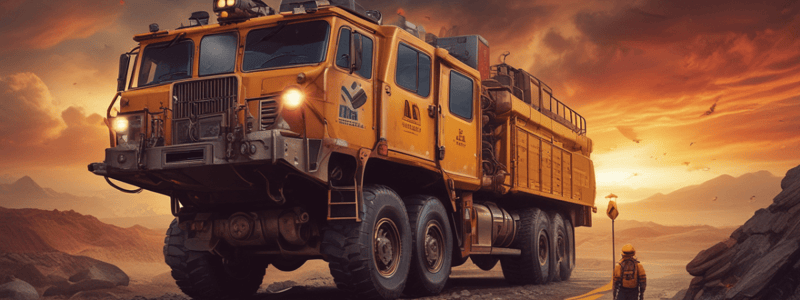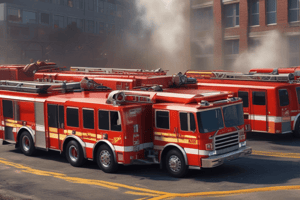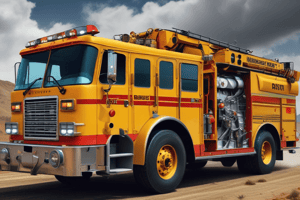Podcast
Questions and Answers
Match the following stages of a fire with their descriptions:
Match the following stages of a fire with their descriptions:
Incipient = Fire gases begin to fill the fire area Growth = Dense black smoke Fully Developed = Rollover is visible, little or no visible flame Decay = Smoke-stained or blackened windows
Match the following fire-gases with their examples:
Match the following fire-gases with their examples:
Toxic Smoke = Carbon monoxide, hydrogen cyanide, and chlorine Clean Air = Oxygen, nitrogen, and helium Fire Gases = Water vapor, carbon dioxide, and smoke Harmless Gases = Helium, oxygen, and nitrogen
Match the following fire signs with their descriptions:
Match the following fire signs with their descriptions:
Dense black smoke = Indicates a fully developed fire Rollover = Indicates an incipient fire Smoke emanating under pressure = Indicates a growing fire Little or no visible flame = Indicates a decay stage
Match the following fire extinguisher ratings with their descriptions:
Match the following fire extinguisher ratings with their descriptions:
Match the following fire signs with their stages:
Match the following fire signs with their stages:
Match the following fire characteristics with their descriptions:
Match the following fire characteristics with their descriptions:
Match the following fire extinguisher ratings with their features:
Match the following fire extinguisher ratings with their features:
Match the following fire signs with their characteristics:
Match the following fire signs with their characteristics:
Match the following fire stages with their signs:
Match the following fire stages with their signs:
Match the following fire extinguisher features with their descriptions:
Match the following fire extinguisher features with their descriptions:
Flashcards are hidden until you start studying
Study Notes
Mine Rescue Team Structure
- The team structure includes: Decision-making Processes, Personal Protective Equipment requirements, Fresh Air Bases/Zones, and First Response to Hazardous Materials
- Ensuring the team is response-ready, ensuring breathing apparatus and auxiliary equipment are response-ready, and ensuring safe operation of all rescue equipment
- Knowledge of all facilities at the mine, relevant fire, explosive, electrical, mechanical, and chemical hazards, ventilation principles, and mine gases
- Directing and assisting the work of team members at the scene, determining and inspecting all aspects of a rescue operation, and establishing and maintaining incident scene security and control
- Exploring the affected area of the mine, rope work and rigging, firefighting, first aid, and extrication
Industrial Scientific Rescue
- No information provided
Communication
- Communication within the emergency response structure
- Communication by team members
Time Management
- Active Team (Max. 2 hrs.)
- Back-up Team
- Team at Rest
- Time management plan for the rescue operation
Gas Hazards
Air Gas Mixture (AIR)
- Blasting or other explosions
- Mine fires
- Diffusion from ore or country rock, as with methane or radon
- Decay of mine timber
- Absorption of oxygen by water or oxidation of timber or ore
- Use of diesel motors underground
- Gas released from thermal water -- carbon dioxide, hydrogen sulphide
Acetylene (C₂H₂)
- No information provided
Ammonia (NH₃)
- Move the leaking cylinder to an exhaust hood or safe outdoor area for venting
- Mark the empty cylinder DEFECTIVE
- Use a water spray or fog to reduce the gas cloud from a serious leak or spill
- If possible, turn the leaking cylinder so that gas rather than liquid escapes
- Isolate the area until the gas has dispersed
Toxic Gas Hazards
- Carbon monoxide: always present at the time of a fire and gives little or no warning of its presence
- Oxygen deficiency: occurs when oxygen is consumed by combustion or chemical reaction and is replaced by toxic or inert gases
- Explosive gases and smoke: irritating qualities and obstructs vision
- Methane: may cause fires or explosions
- Sulphur Dioxide: present when a fire occurs in a sulphide ore body
- Other gases: Hydrogen sulphide, nitrous oxides, hydrogen cyanide, etc.
Fire Stages
- Incipient
- Growth
- Fully Developed
- Decay
Fire Behavior
- Dense black smoke
- Fire gases begin to fill the fire area
- Rollover is visible
- Little or no visible flame
- Smoke emanating under pressure from cracks, i.e., around windows or doors
- Smoke may be drawn back in
- Smoke is exiting in puffs or intervals
- Black smoke becoming dense grey yellow
- Smoke-stained or blackened windows
Studying That Suits You
Use AI to generate personalized quizzes and flashcards to suit your learning preferences.




